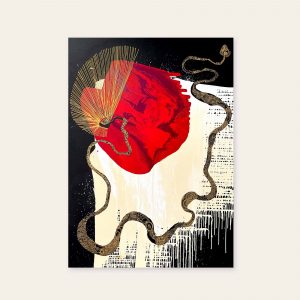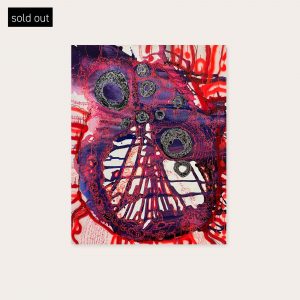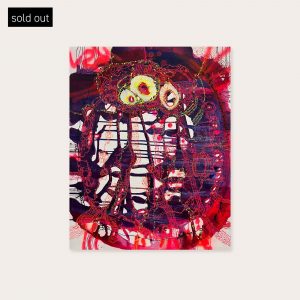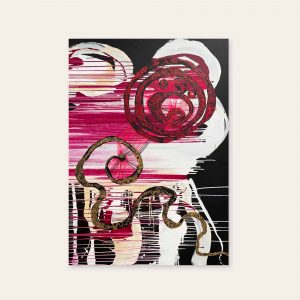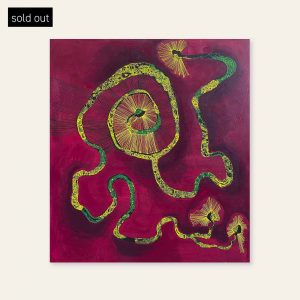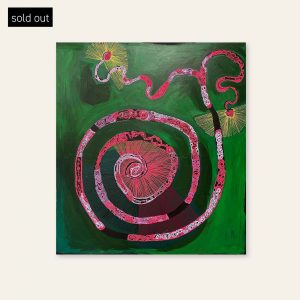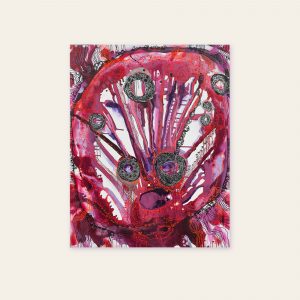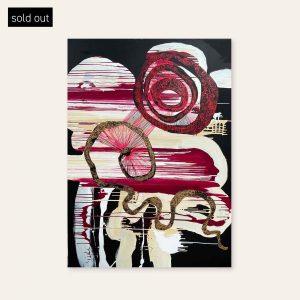Zaachariaha Fielding
Manguri – Halo
15.06. - 21.07.24
[EN]
We are thrilled to present ‘Manguri – Halo’ the first solo exhibition by Zaachariaha Fielding in Europe. The exhibition showcases works by the Anangu Pitjantjatjara Yankunytiatjara artist between June 15 and July 21, 2024 at Galerie Grolman, Berlin.
„Manguri in the Pitjantjatjara language is a woven ring that sits on the top of the head. Manguri holds the piti (bowl or vessel) that is used to collect food and other items as someone walks through the bush. The Manguri holds the piti in position; stabilises it. Anangu (Aboriginal people from the APY Lands) use Manguri when travelling long distances, to collect things as they travel and hold what they can’t carry just with their hands. Without Manguri, these essential things can’t be collected. For me Manguri or halo is a symbol of knowledge holding, stability/instability and survival. These are common themes in my life and my visual arts practice. I consider myself a collector- of experiences, perspectives, ideas, stories (both ancestral and contemporary) and judgements. I pick up these pieces of information as I move through life, trying to look at them and make sense of them. Sometimes they go in the ‚too hard basket‘ for later, sometimes I hold onto them as a source of joy I can call on at any time. Regardless, you need a strong framework for what you can hold as a human, and Manguri is that for me.“ Zaachariaha Fielding, May 2024
[DE]
About the Artist:
Zaachariaha Fielding (*1991) is a multi-disciplinary artist originally from the Mimili Community in the Aṉangu Pitjantjatjara Yankunytjatjara (APY) Lands, currently working out of the APY Collective on Kaurna land/Adelaide. Fielding’s energetic and visceral paintings exist as contemporary works whilst acknowledging and honoring the visual language of their culture. Fielding’s creative and cultural spirit lays bare the constellations of his emotions, memories and experiences in his artworks. About his work, Fielding shares: “I was raised on desert country in the eastern Anangu Pitjantjatjara Yankunytjatjara Lands, and come from a long line of multidisciplinary artists. I am compelled to make work that honors the visual language of my ancient culture. The iconography reflects the way I live my culture in the present, as a constant feature of my world, and visualizes how I interact with the beings that populate the Tjukurpa I’ve inherited.”
Having established himself as a critically acclaimed musician, as one half of the duo Electric Fields, Fielding is compelled to create art in whichever form is available: A few weeks ago, Electric Fields represented Australia at Eurovision performing the song “One Milkali (One Blood)” in Sweden – each track a mashup of electric soul and Indigenous storytelling, animated by Fielding’s rich, androgynous tone singing lyrics alternately in Pitjantjatjara, Yankunytjatjara and English. Fresh from representing Australia in Eurovision 2024, Fielding last stuns at Australian Fashion Week with ‘Romance Was Born’ collaboration.
Fielding’s artistic work has been recognised in major art awards, most notably as Winner of The Wynne Prize – Australia’s oldest prize for landscape painting – by the Art Gallery of New South Wales (2023); a finalist in the Ramsay Art Prize at Art Gallery of South Australia (2021); and the National Aboriginal and Torres Strait Islander Art Awards at Museum and Art Gallery of Northern Territory (2021). His work is currently held in important public collections including the National Gallery of Victoria, Artbank and numerous private collections.

